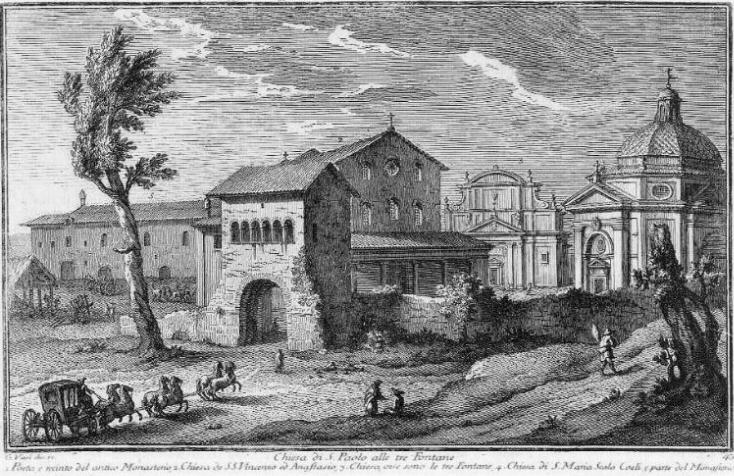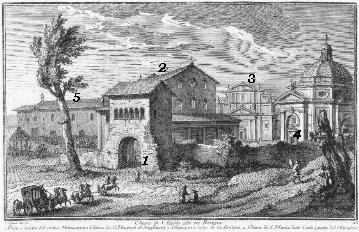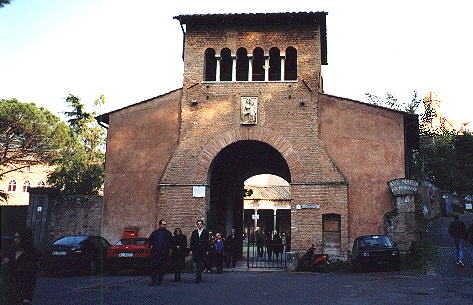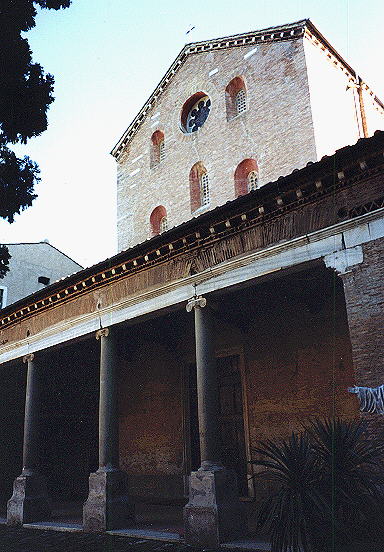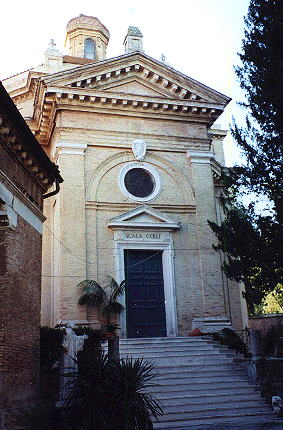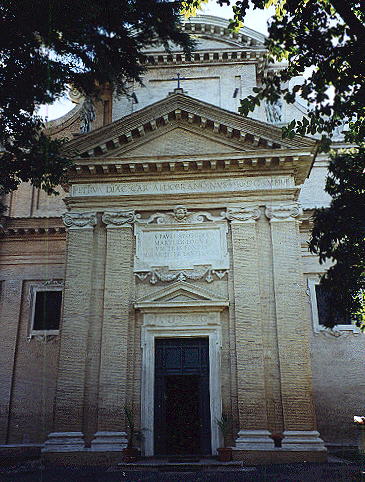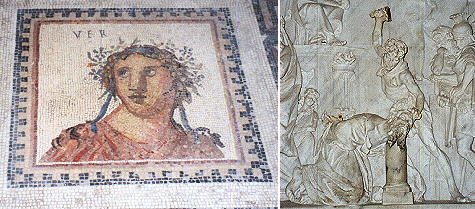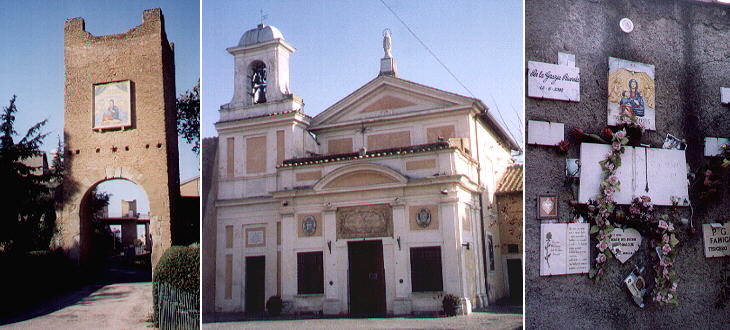

S. Paolo
alle Tre Fontane (Book
3) (Day 5) (View C12)
In this page:
The plate by Giuseppe Vasi
Today's view
SS. Vincenzo e Anastasio
S. Maria Scala Coeli
S. Paolo alle Tre Fontane
Santuario della Madonna del Divino Amore
The Plate (No. 43)
The Abbey was built on the site where St. Paul was executed. His
head made three leaps corresponding to which were welled three fountains.
We are very far from Rome off Via Ostiense in a location often abandoned
because of its unhealthiness. In the description below the plate Vasi made reference to: 1) the main gate and the walls surrounding the monastery; 2) SS. Vincenzo e Anastasio; 3) S. Paolo alle tre Fontane; 4) S. Maria Scala Coeli; 5) Part of the monastery.
Today
The entrance to the Abbey is what is left of a church dedicated to
St. John the Baptist. It became the gate of a stretch of walls built to
protect the Abbey.
SS.
Vincenzo e
Anastasio
The church has retained its original medieval looks, with the typical
portico of many Roman churches.
S.
Maria Scala
Coeli
The name refers to a vision of a heavenly ladder by St. Bernard.
The present church dates to the end of the XVIth century and it was designed by Giacomo della Porta.
S.
Paolo alle Tre
Fontane
The church contains the three springs which give the name to the
Abbey. It was completed in 1599. Pius IX in celebration of the 1867 victory
of Mentana against Garibaldi restored it and brought here a Roman mosaic
(the Four Seasons) discovered in Ostia. A relief with the execution of
St. Paul is also a XIXth century addition.
Santuario
del Divino Amore
In 1744 a man attacked by stray dogs prayed for help before an image of the Virgin Mary painted on the main gate of Castel di Leva, once a fortress of the Orsini.
He was miraculously spared by the dogs and the image soon became popular and other miracles were attributed to the
intercession of the image called Madonna del Divino Amore. In 1744 a sanctuary was erected to preserve the image.
The location of Castel di Leva (between Via Appia and Via Ardeatina) can be seen in a map showing the
environs of Rome (click here: Castel di Leva is to the left of the letter G). The sanctuary became extremely popular in 1943 when Pope Pius XII entrusted the safety of Rome to Madonna del Divino Amore.
Excerpts from Giuseppe Vasi 1761 Itinerary related to this page:
Chiesa di s. Paolo alle tre fontane
Dicevasì anticamente questo sito ad aquas salvias, ed ancora ad guttam jupiter manantem:
in cui l'Apostolo s. Paolo fu condotto, e decapitato. Tre chiese sono in questo luogo
la prima fu eretta da Onorio I. l’anno 626. e fu dedicata ai ss. Vincenzo ed Anastasio.
Leone III. la riedificò da' fondamenti, e Carlo Magne la dotò di città, castelli, molte
terre, e poderi. Innocenzo II. nel 1140. la concede ai Monaci Cisterciensi, e vi edificò
un monastero, in cui il primo Abate mandatovi da s. Bernardo, fu eletto Papa col nome di
Eugenio III.
La seconda cappella, o chiesa rotonda, che le sta di fianco era prima dedicata
a s. Gio. Batista; ma celebrando una volta in essa s. Bernardo per li fedeli defunti,
fu rapito in estasi, e vide, che per una scala lunga sino al cielo salivano le anime
liberate dal purgatorio; onde essendo poi dal Card. Alessandro Farnese alzata di
nuovo la chiesa col disegno di Giacomo della Porta, e poi terminata dal Card.
Pietro Aldobrandini, fu dedicata alla ss. Vergine col titolo di Scala Coeli.
Si vede sotto di questa l'antichissimo cimiterio di s. Zenone, dove furono
sepolti dieci mila corpi di ss. Martiri, e si crede che siano stati di que'
Cristiani, che, come dicemmo, dopo aver lavorato nelle terme Diocleziane,
quivi furono fatti morire.
La terza cappella o chiesa, è quella poco discosto, eretta nel sito ove s. Paolo
fu decollato, e si vedono ancor perenni le tre fontane nate miracolosamente ne' tre salti,
che fece il suo sagro capo. Il riferito Card. Aldobrandini rinnovò tutto col disegno
del mentovato Giacomo della Porta, e fece metter la colonna, a cui si crede, che il
s. Apostolo fosse legato, appresso al primo fonte, per indicare il primo salto, che
fece la testa subito recisa. La Crocifissione di s. Pietro, che vede sull'altare, è
opera insigne di Guido Reni, la Decollazione di Paolo, che sta incontro è di
Bernardino Passerotto, e le due statue sul prospetto sono del Franciosino.
|
Next plate in Book 3: Chiesa di S. Maria in Via Lata
Next step in Day 5 itinerary: Basilica di S. Paolo
fuori delle mura

Go
to  or to Book
3 or to my Home
Page on Baroque Rome or to my Home Page on Rome
in the footsteps of an XVIIIth century traveller.
or to Book
3 or to my Home
Page on Baroque Rome or to my Home Page on Rome
in the footsteps of an XVIIIth century traveller.
|


